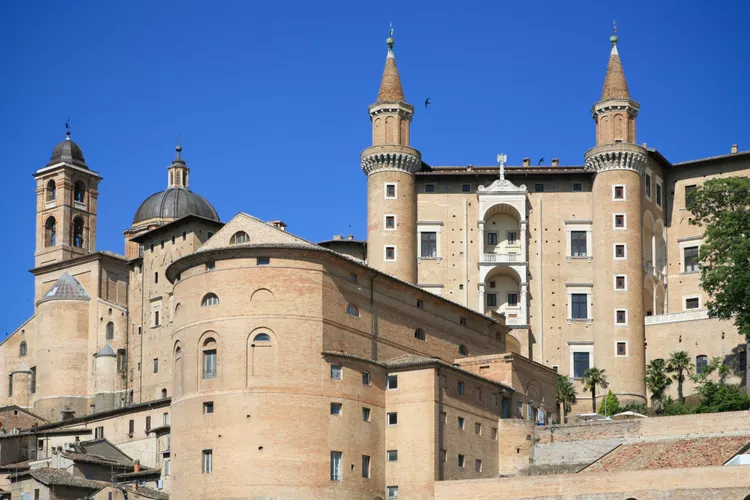1. Overview of Urbino’s Ducal Palace
2. National Gallery of the Marche Renaissance Art Collection
3. Visiting Information for Palazzo Ducale
4. Exploring Urbino
Urbino’s Ducal Palace, or Palazzo Ducale, was the first ducal palace to be built in Italy. It was constructed in the 15th century by Duke Federico da Montefeltro. Often referred to as a town in the shape of a palace, it housed 500 to 600 inhabitants, including numerous servants needed for its operations. The extensive underground rooms where the servants worked and lived have been renovated and opened to the public. Below the palace were stables, kitchens, laundry rooms, an ice room for refrigeration, and the Duke’s baths, reminiscent of Roman baths.
Duke Federico was a patron of the arts, deeply committed to the study of literature and humanities. Unfortunately, his vast collection of books and illuminated manuscripts was taken to the Vatican Museums in the 18th century. Although little of the original furniture and wall decor remains, a highlight is the Duke’s original small study, adorned with inlaid wood scenes depicting books, musical instruments, scientific instruments, and historical figures, including Greek philosophers and Biblical characters. Near the study are two small chapels—one featuring the Temple of the Muses, painted by Santi, Raffaello’s father, and the other known as the Temple of Forgiveness.
National Gallery of the Marche Renaissance Art Collection
Since 1912, the Palazzo Ducale has been home to the National Gallery of the Marche, which houses one of the world’s most significant collections of Renaissance paintings displayed in 80 of the palace’s renovated rooms. Many 15th-century artworks originally found in churches throughout the Marche are exhibited in the gallery. Notable pieces include two works by Piero della Francesca: the Flagellation and Madonna di Senigallia.
The renowned Renaissance painter Raphael (Raffaello) was born in Urbino, and several of his works are featured in the gallery. Additionally, 17th-century tapestries in a major room depict scenes inspired by Raphael. Moreover, visitors can explore his home in town, which is now a museum.
Other significant artworks consist of crucifixes made by students of Giotto, as well as a sampling of 17th-century Baroque paintings.
Palazzo Ducale Visiting Information
For admission hours and fees, checking the Palace’s official website is recommended. Although the information is in Italian, contact details such as a phone number and email address are readily available. Tours in English are also offered.
Exploring Urbino
The Renaissance city of Urbino, a walled hill town nestled in central Italy’s Marche region, is undoubtedly worth a visit. In the 15th century, Urbino became a renowned center for distinguished artists and scholars, highlighted by its university established in 1506. Notably, Urbino also emerged as a pivotal center for high-quality majolica, making it a delightful shopping destination. The city’s historic center enjoys recognition on the list of UNESCO World Heritage Sites.
Furthermore, the Duke maintained a summer palace located in Urbania, a nearby walled medieval town that also merits exploration.





